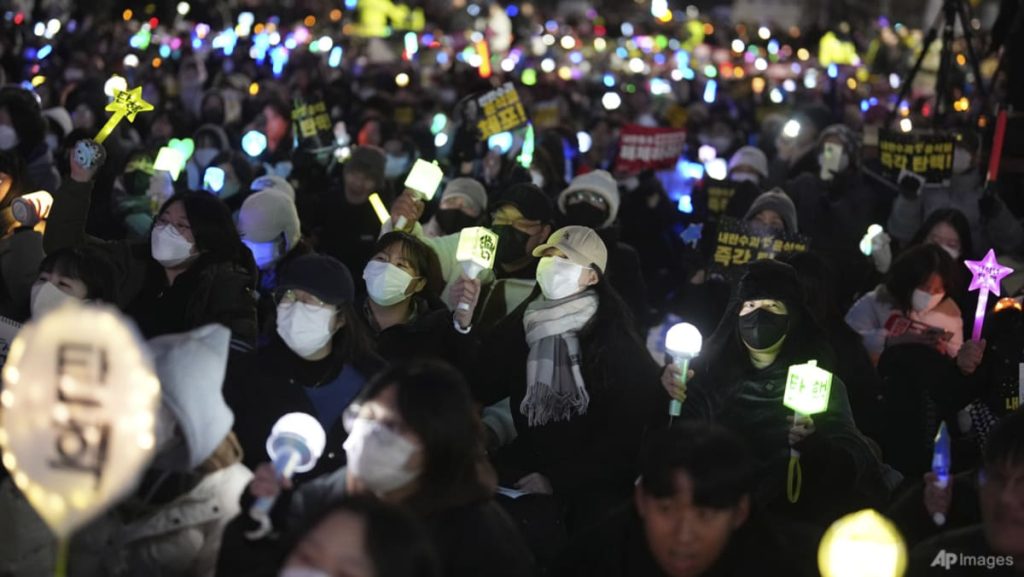The confluence of political protest and nostalgic cultural touchstones has created a unique and potent form of expression in South Korea, centered around the impeachment of President Yoon Suk Yeol. A wave of public discontent has manifested in demonstrations incorporating familiar elements from shared cultural memory, transforming everyday symbols of the past into vehicles for contemporary political commentary. This phenomenon is exemplified by the adaptation of Christmas carols and school exercise routines into rallying cries for Yoon’s removal from office. The blending of these seemingly disparate elements underscores the deeply personal and emotionally charged nature of the current political climate, with citizens drawing upon shared experiences to voice their dissatisfaction.
The reimagining of Christmas carols, typically associated with joy and celebration, into protest anthems showcases the ingenuity and adaptability of the demonstrators. Singer Baek Ja’s tweaked rendition of “Feliz Navidad,” with its pointed lyric “Christmas is merry when Yoon Suk Yeol resigns,” encapsulates this sentiment. By appropriating a widely recognized and beloved holiday tune, the protesters infuse their message with a sense of irony and urgency, highlighting the perceived dissonance between the festive season and the political turmoil gripping the nation. This tactic effectively subverts the traditional meaning of the carol, transforming it into a vehicle for expressing discontent and demanding political change. The use of a familiar melody ensures broad recognition and resonates with a wider audience, amplifying the protest’s message and potentially garnering greater support.
The appropriation of school exercise routines from the 1980s and 1990s adds another layer of cultural significance to the protests. These routines, ingrained in the collective memory of many South Koreans, evoke a sense of shared experience and nostalgia. By performing these familiar exercises while chanting “Arrest Yoon Suk Yeol,” protesters tap into a shared cultural reservoir, imbuing their actions with a sense of collective identity and solidarity. This nostalgic element not only strengthens the bonds between protesters but also serves as a poignant reminder of a simpler time, implicitly contrasting it with the perceived instability and corruption of the current political landscape. The juxtaposition of youthful, energetic movements with the serious demand for presidential impeachment creates a striking visual and emotional impact, further amplifying the message of dissent.
The choice of location for these demonstrations, in front of the National Assembly building, underscores the targeted nature of the protests. This symbolic setting, the heart of South Korea’s legislative power, serves as a direct address to the political establishment. The protesters’ presence at this location highlights their demand for accountability and their desire for direct engagement with the political processes they seek to influence. The combination of the familiar cultural elements with the highly visible and politically charged location maximizes the impact of the protests, ensuring they receive widespread attention and effectively communicate the demonstrators’ message to both the government and the broader public.
The visual elements of the protests further enhance their impact. The use of protest signs with slogans such as “Arrest (Yoon) immediately” and “Impeach” clearly articulates the demonstrators’ demands, leaving no room for ambiguity. The illuminated candles and cellphones, reminiscent of peaceful vigils and demonstrations throughout history, create a visually compelling spectacle, symbolizing both hope and collective resolve. The presence of glow sticks and warm winter clothing, while practical necessities in the cold weather, also contribute to the overall visual impact, creating a sense of unity and shared purpose amongst the demonstrators. These visual elements, combined with the adapted carols and exercise routines, create a multi-layered and powerful form of protest that transcends traditional methods of political expression.
The fusion of political protest with nostalgic cultural elements represents a powerful and innovative approach to expressing dissent. By appropriating familiar tunes and routines, protesters create a sense of collective identity and shared experience, amplifying their message and resonating with a broader audience. The choice of location, the visual elements, and the adaptation of recognizable cultural touchstones all contribute to the overall impact of the demonstrations, effectively communicating the protesters’ demands and highlighting the depth of public dissatisfaction with the current political climate. This unique form of protest, blending the personal with the political, underscores the profound impact of President Yoon’s leadership on South Korean society and the fervent desire for change amongst a segment of the population.

